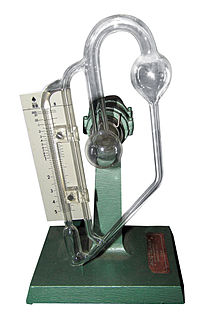Related Research Articles

Sir John Edward Lennard-Jones was a British mathematician and professor of theoretical physics at the University of Bristol, and then of theoretical science at the University of Cambridge. He was an important pioneer in the development of modern computational chemistry and theoretical chemistry.

The Hughes Medal is awarded by the Royal Society of London "in recognition of an original discovery in the physical sciences, particularly electricity and magnetism or their applications". Named after David E. Hughes, the medal is awarded with a gift of £1000. The medal was first awarded in 1902 to J. J. Thomson "for his numerous contributions to electric science, especially in reference to the phenomena of electric discharge in gases", and has since been awarded over one-hundred times. Unlike other Royal Society medals, the Hughes Medal has never been awarded to the same individual more than once.
Sir Ralph Howard Fowler was a British physicist and astronomer.

Dame Kathleen Lonsdale was an Irish-born British pacifist, prison reformer and crystallographer. She proved, in 1929, that the benzene ring is flat by using X-ray diffraction methods to elucidate the structure of hexamethylbenzene. She was the first to use Fourier spectral methods while solving the structure of hexachlorobenzene in 1931. During her career she attained several firsts for female scientists, including being one of the first two women elected a Fellow of the Royal Society (FRS) in 1945, first woman tenured professor at University College London, first woman president of the International Union of Crystallography, and first woman president of the British Association for the Advancement of Science.

Sir Franz Arthur Friedrich Schuster was a German-born British physicist known for his work in spectroscopy, electrochemistry, optics, X-radiography and the application of harmonic analysis to physics. Schuster's integral is named after him. He contributed to making the University of Manchester a centre for the study of physics.

The Department of Physics and Astronomy at the University of Manchester is one of the largest and most active physics departments in the UK, taking around 250 new undergraduates and 50 postgraduates each year, and employing more than 80 members of academic staff and over 100 research fellows and associates. The department is based on two sites: the Schuster Laboratory on Brunswick Street and the Jodrell Bank Centre for Astrophysics in Cheshire, international headquarters of the Square Kilometre Array (SKA).

Herbert McLeod, FRS was a British chemist, noted for the invention of the McLeod gauge and for the invention of a sunshine recorder.

Walter Crum FRS (1796–1867) was a Scottish chemist and businessman. He became a Fellow of the Royal Society in 1844.

Rev William Galbraith was a Scottish mathematician. He taught mathematics and nautical astronomy in Edinburgh, and took an interest in surveying work, becoming an advocate of the extension of the work of triangulating Great Britain.
Sir William Somerville KBE FRSE LLD (1860–1932) was a 19th/20th century Scottish agriculturalist. He is one of the few academics to have taught at both Cambridge University and Oxford University. He was twice President of the Arboricultural Society: 1900–1901 and 1922–1924.
References
- ↑ "Fellows of the Royal Society". London: Royal Society. Archived from the original on 2015-03-16.
- ↑ "John Anderson". Oxford Dictionary of National Biography (online ed.). Oxford University Press. doi:10.1093/ref:odnb/489.(Subscription or UK public library membership required.)
- ↑ "Miles Joseph Berkeley (BRKY820MJ)". A Cambridge Alumni Database. University of Cambridge.
- ↑ Edgar F. Smith; W. R. Dunstan; B. A. Keen; Frank Wigglesworth Clarke (1923). "Obituary notices: Charles Baskerville, 1870–1922; Alexander Crum Brown, 1838–1922; Charles Mann Luxmoore, 1857–1922; Edward Williams Morley, 1838–1923; William Thomson, 1851–1923". J. Chem. Soc., Trans. 123: 3421–3441. doi:10.1039/CT9232303421.
- ↑ "Richard Assheton Cross". Oxford Dictionary of National Biography (online ed.). Oxford University Press. doi:10.1093/ref:odnb/32644.(Subscription or UK public library membership required.)
- ↑ O'Connor, John J.; Robertson, Edmund F., "George Howard Darwin", MacTutor History of Mathematics archive , University of St Andrews
- ↑ Pope, W. J. (24 January 1925). "Obituary: G. D. Liveing, F.R.S." Nature. 115: 127–129. Bibcode:1925Natur.115..127P. doi: 10.1038/115127a0 .
- ↑ "George Matthey". Oxford Dictionary of National Biography (online ed.). Oxford University Press. doi:10.1093/ref:odnb/47907.(Subscription or UK public library membership required.)
- ↑ "George John Romanes (1848–94)". Nature. 161 (4098): 757. 1948. Bibcode:1948Natur.161S.757.. doi: 10.1038/161757c0 . ISSN 0028-0836.
- ↑ Simpson, G. C. (1935). "Sir Arthur Schuster. 1851–1934". Obituary Notices of Fellows of the Royal Society . 1 (4): 408–423. doi:10.1098/rsbm.1935.0006. JSTOR 768973.
- ↑ Chapman, S. (1934). "Arthur Schuster, 1851–1934". Journal of Geophysical Research. 39 (4): 341. Bibcode:1934TeMAE..39..341C. doi:10.1029/TE039i004p00341. ISSN 0148-0227.
- ↑ L., R. (1909). "Prof. H. G. Seeley, F.R.S." Nature. 79 (2046): 314–315. Bibcode:1909Natur..79..314L. doi: 10.1038/079314b0 . ISSN 0028-0836.
- ↑ . Encyclopædia Britannica (11th ed.). 1911.
- ↑ Sticker, Bernhard (1970). "Auwers, Arthur Julius Georg Friedrich von". Dictionary of Scientific Biography . Vol. 1. New York: Charles Scribner's Sons. pp. 339–340. ISBN 0-684-10114-9.
- ↑ O'Connor, John J.; Robertson, Edmund F., "Luigi Cremona", MacTutor History of Mathematics archive , University of St Andrews
- ↑ Luigi Cremona at the Mathematics Genealogy Project
- ↑ Georg Hermann Quincke at the Mathematics Genealogy Project
- ↑ Morley, Edward W. (1892). "Jean Servais Stas". Journal of the American Chemical Society. 14 (7): 173–189. doi:10.1021/ja02123a012. ISSN 0002-7863.